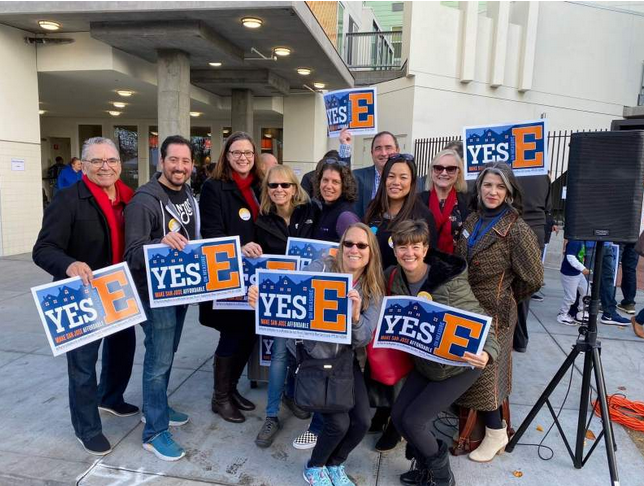San Jose voters are currently voting (yes, the vote has started already, and will be ongoing now through March 3) on Measure E, a ballot initiative that would generate $22 to $73 million annually to increase the city's affordable housing stock and combat homelessness. Streetsblog urges our readers in San Jose to vote "Yes" on Measure E.
San Jose is now the most expensive city in the country for first-time homeowners, and the average rent is twice the national average. Long-time residents, especially those in communities that are seeing or expecting a flood of new workers in the tech industry, are feeling the pressure as the cost of living rises. It's no wonder the city's homeless population grew by forty percent since 2017.
One of the best parts of Measure E is that it raises funds to help battle the affordability and homeless crisis without increasing the burden on disadvantaged communities.
Measure E is a transfer tax on luxury homes and commercial properties valued over $2 million. Fess aren't collected annually, only when these homes are sold. Even with currently high real estate prices, the city estimates that Measure E would only impact the top two percent of property sales in San Jose.
A transfer tax is based on a home’s property value. If Measure E passes, the rate would be $3.75 per $500 for $2 million-$5 million properties, $5 per $500 for $5 million-$10 million properties and $7.50 per $500 for properties worth more than $10 million. Measure E would place these fees on top of the city’s current property transfer tax, which is applied to properties at a rate of $3.30 per $1,000.
The new tax should not dampen enthusiasm for San Jose's real estate market, as it would still be lower than tax rates in other Bay Area cities. San Francisco’s rates range between $5-30 and Oakland’s between $10-$25. Post Measure E, San Jose's rates would be $3.30-$18.30 per $1.000.
In December, the San Jose City Council passed a spending plan for Measure E funds. While a future Council could overrule this plan with a 2/3 vote, the current Council passed it overwhelmingly, 9-2. The plan the Council passed allocates Measure E funds new housing construction broken down thus:
- 45 percent for extremely low income households (below 30 percent of area median income, or AMI)
- 35 percent for very low income and low income households (30-80 percent of AMI)
- About 10 percent for moderate-income households (80-120 percent of AMI) and below-market-rate housing
- 10 percent for homeless prevention activities
The list of groups and elected officials endorsing Measure E is a long one that includes a super-majority of the San Jose City Council, SPUR, the Greenbelt Alliance, and Housing Trust Silicon Valley. Organized opposition to Measure E comes from Citizens for Fiscal Responsibility, a San Jose-based budget-watchdog organization.
In an op/ed at San Jose Spotlight, Citizens for Fiscal Responsibility lay out two reasons to be wary of Measure E: the city has not returned existing services to pre-recession levels and there is nothing to stop a future city council from overturning the intent of the voters to spend these funds.
The first argument seems spurious. After all, what service could be more important than addressing the needs of residents who cannot afford to live in the city during a statewide affordability and homeless crisis?
The second point is more concerning, as California has a long history of taking funds that voters support for one project and spending them on another. However, with a super majority supporting the current spending plan, a lot of city council votes would have to change for the city to go back on its promises to voters to spend these funds on the affordable units that are promised.
Measure E is a strong measure to help combat both rising housing costs and homelessness. We urge you to vote "Yes."






